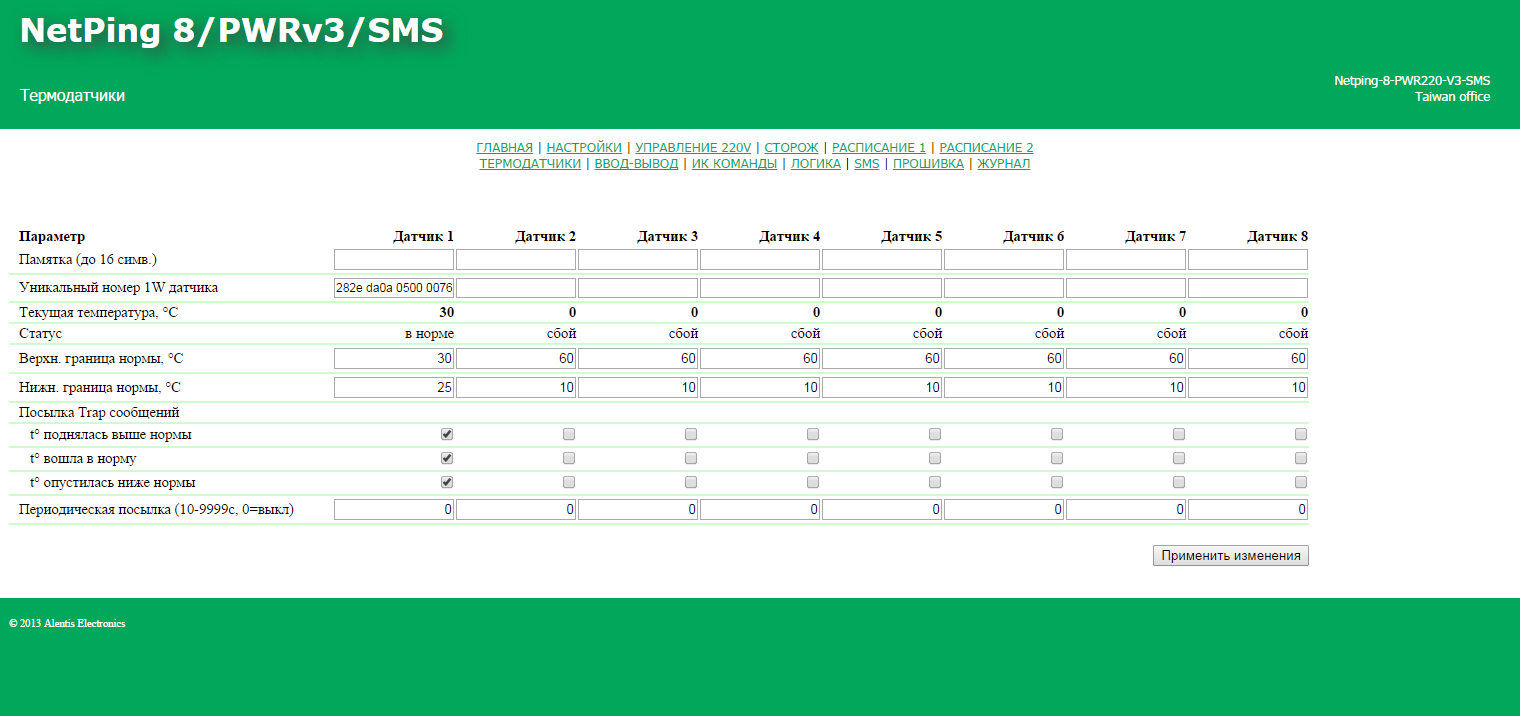[DKSF 48.2 IU] Page TEMPERATURE web interface
This page shows readings of temperature sensors, which are connected to a device. A device supports temperature sensors of the TS, WT series as well as sensors of the 1-Wire model line. Certain devices support simultaneous connecting of temperature sensors of TS WT and 1-wire types. For the TS and WT sensors, number of sensors 1..8 on the web page of an interface correspond to numbers labelled on bodies of sensors. Readings of a TS or WT sensor automatically appear in a WEB interface 15s after connecting. A 1-Wire sensor is not recommended to connect to the sensor Х if a TS or WT sensor with the number X is connected to the device. 1-Wire sensors have a higher priority than TS and WT sensors. If a conflict arises, a device will display readings of a 1-Wire sensor. To plug a 1-Wire sensor, there is a need to link its unique number to the sensor X in the field “Unique ID of 1W sensor”. You can get to know a unique number of a 1-Wire sensor using any Netping device supporting 1-Wire. To do this, unplug all 1-Wire sensors from a device. Instead, plug the sensor, which unique number you want to know. Go to the address http://<ip_address_of_a_device>/ow_new.cgi . On default, http://192.168.0.100/ow_new.cgi. A unique number of a sensor will be displayed in a browser window. A unique number of a 1-Wire sensor looks like this: 288d f50a 0500 00e4 (16 hexadecimal digits 0..9,a..f; starts from 28). It is possible to plug up to 8 temperature sensors to a device. A temperature value and a status of temperature sensors are updated automatically at least once per minute with no need to reload a page manually. Memo – is a field for setting up a brief description of a temperature sensor. The brief description (memo) is used in Syslog messages and in Logfile, as well as is included into Trap notifications. Its maximum size is 16 characters. On default: empty Current temperature, °C – displays a current temperature of a sensor in degrees of Celsius. A temperature value is updated automatically from time to time without reloading a web-page. Status– displays a current status of a temperature sensor. Its possible values are: Top margin of safe range, °C - is a field for setting up a top margin of a temperature range for each temperature sensor. A temperature range is used to indicate conditions of generating TRAP and Syslog messages. On default: 60 Bottom margin of safe range, °C - s a field for setting up a bottom margin of a temperature range for each temperature sensor. A temperature range is used to indicate conditions of generating TRAP and Syslog messages. On default: 10 Notifications on sensor status change – is a group of settings that allows to define conditions of generating TRAP and Syslog messages. t° is above a safe range – is a checkbox. If checked, a device will send SNMP TRAP and Syslog messages when a current temperature of a temperature sensor exceeds a top margin of a safe range for this temperature sensor. On default: a checkbox is not checked t° is back to a safe range – is a checkbox. If checked, a device will send SNMP TRAP and Syslog messages when a current temperature of a temperature sensor is back to a safe range (it is within the margins of a temperature range specified for this temperature sensor). On default: a checkbox is not checked t° is below a safe range – is a checkbox. If checked, a device will send SNMP TRAP and Syslog messages when a current temperature of a temperature sensor is below a bottom margin of a safe range specified for this temperature sensor. On default: a checkbox is not checked Burst period – is a field for setting up a period of time for forced sending of messages. If its value is 0, then messages are generated only when a sensor status is changed. If the value is not 0, then messages are sent from time to time about a current sensor status within an indicated interval and immediately when a sensor status is changed. On default: 0 After setting up all necessary changes click the button «Apply changes».
